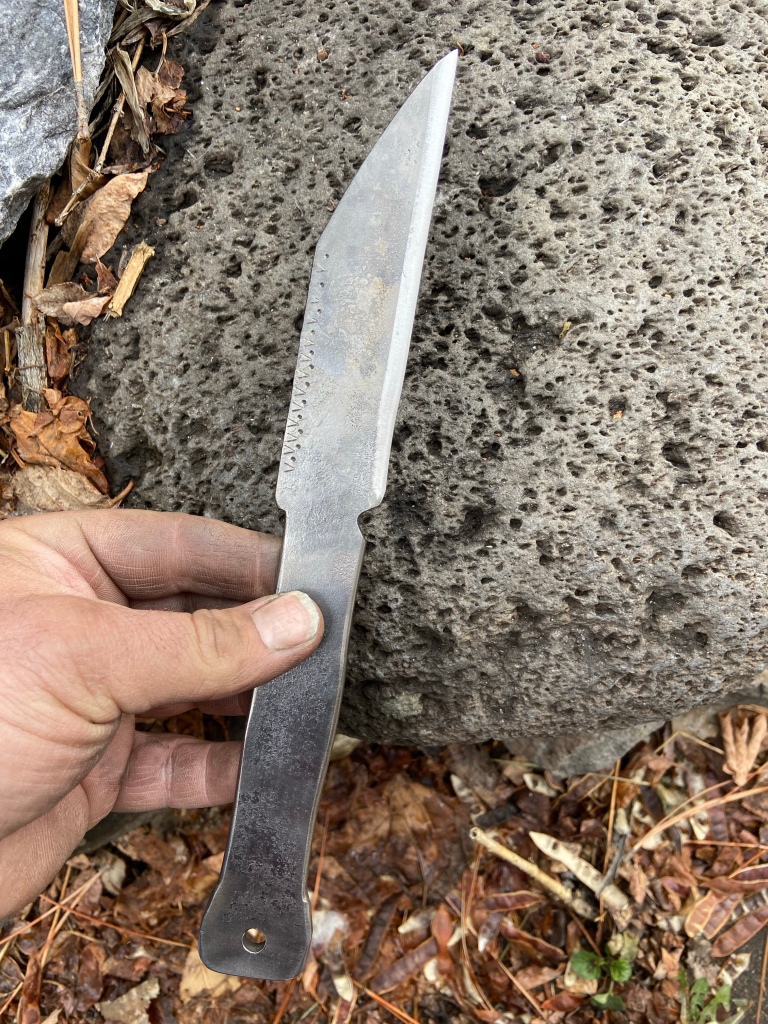Dithmarschen Mjönir
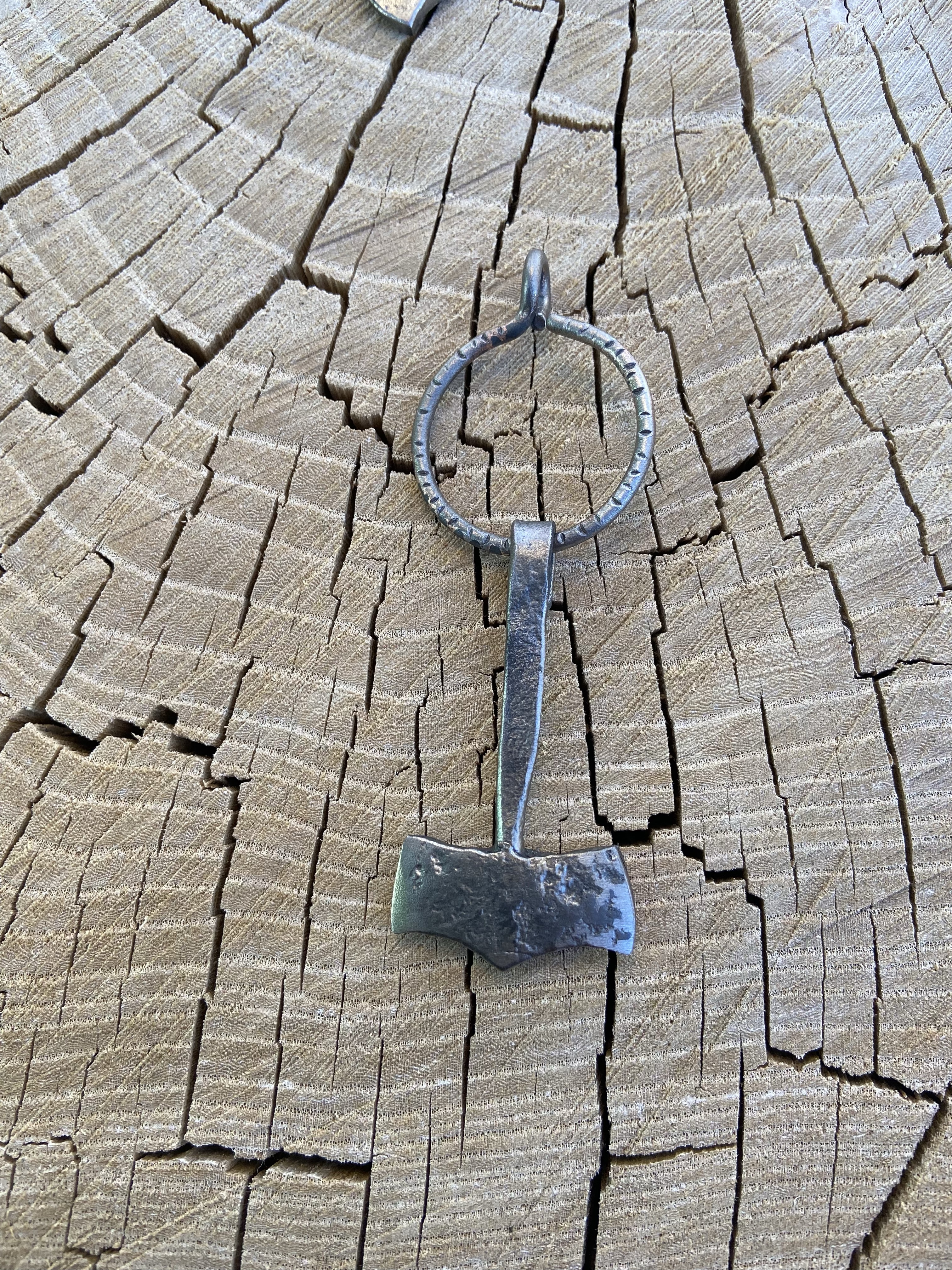
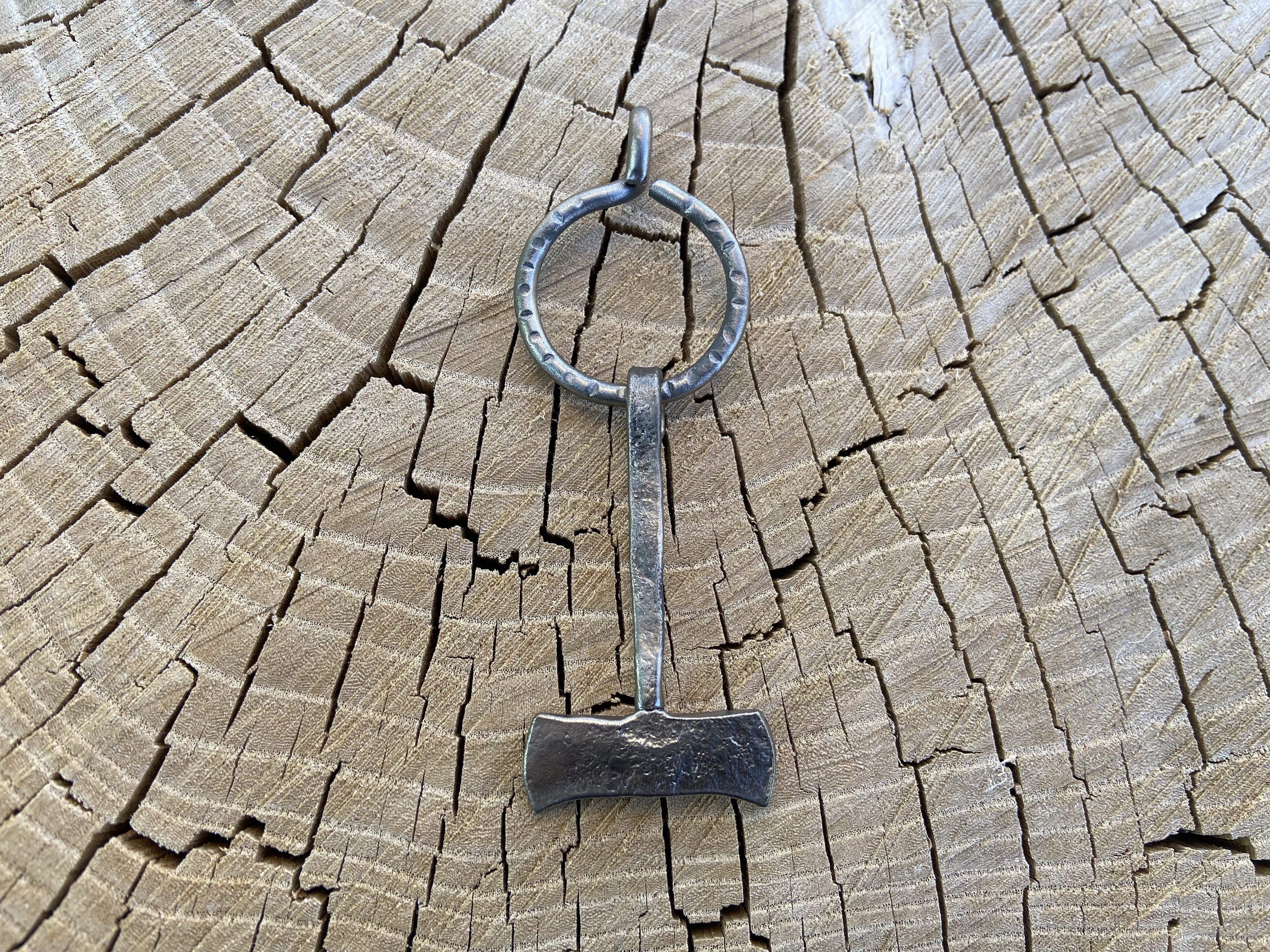
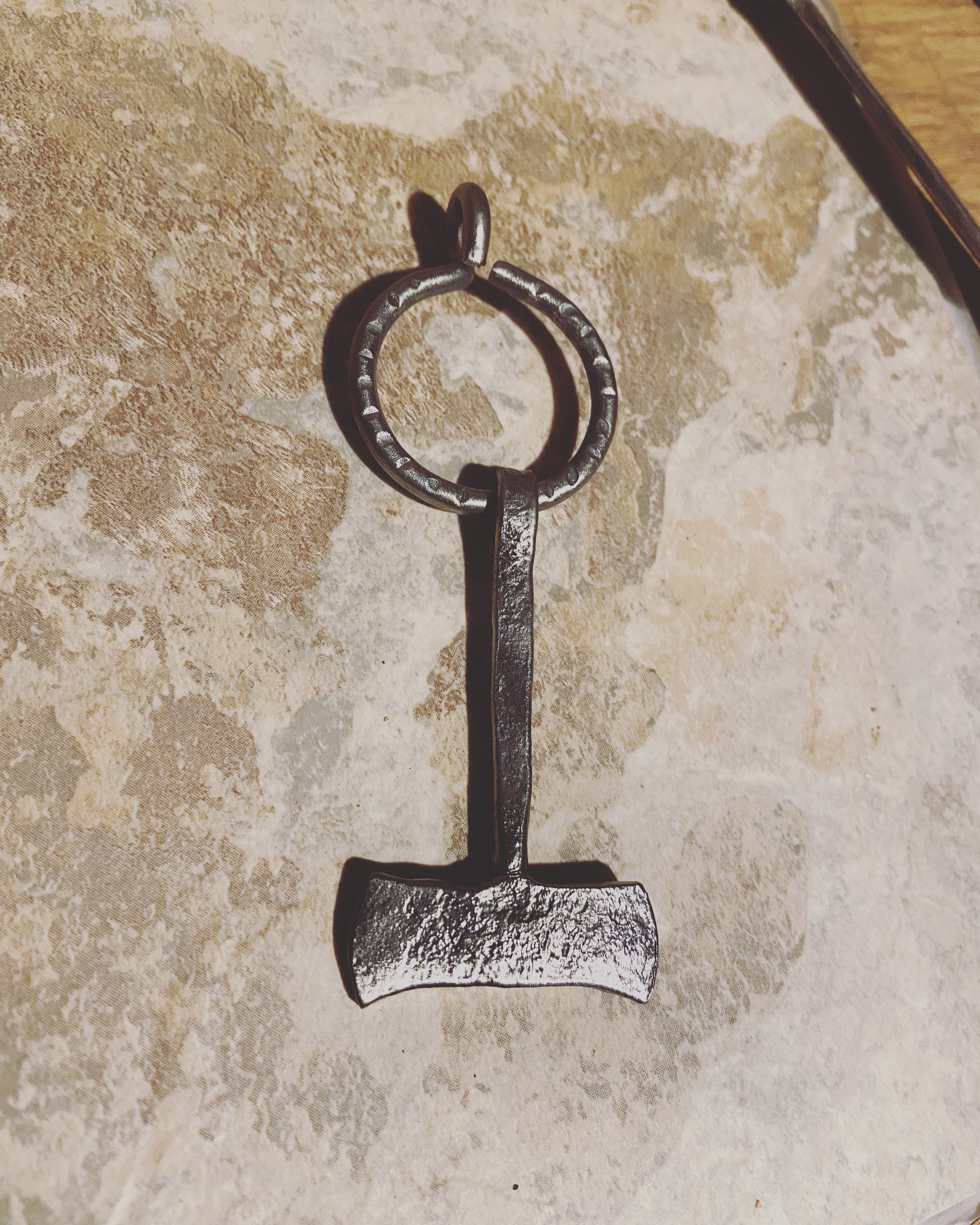
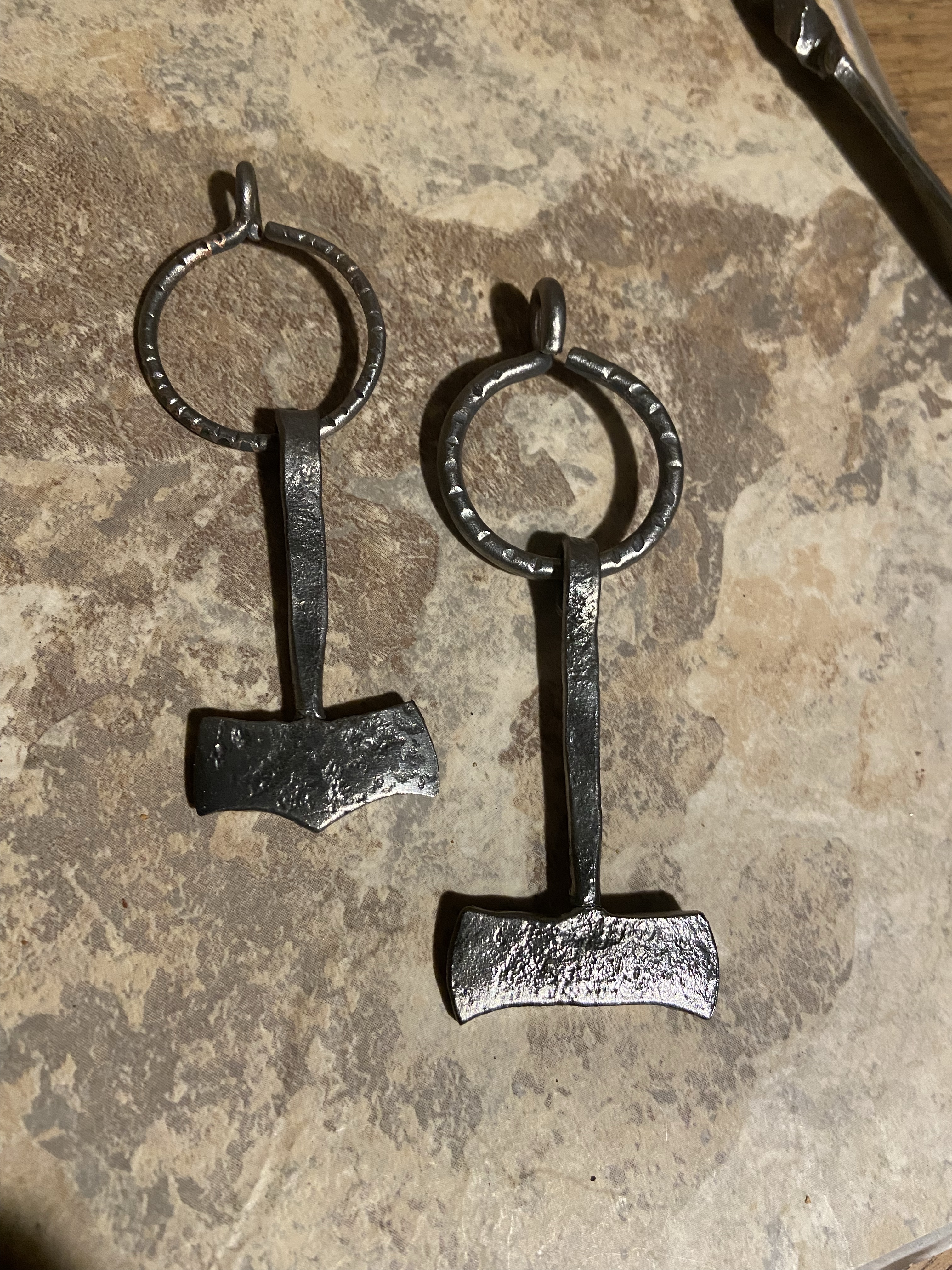
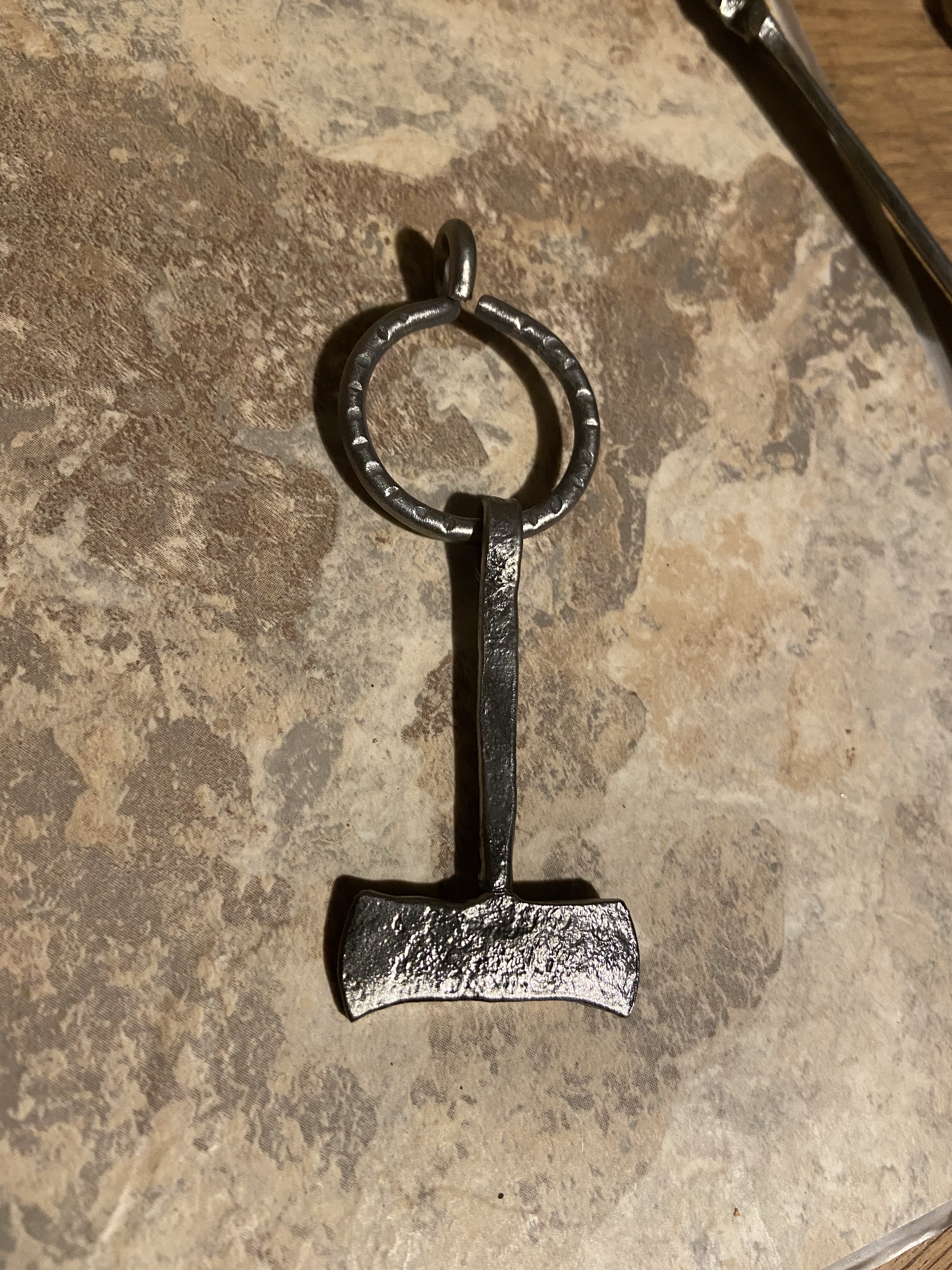
Hroð-
Etsy back up.
https://www.etsy.com/shop/NorseWest
After forever the forge is back in action. Trying to find a trip to Denmark/Germany. no customs just what is on here is available for now. Not back to knives yet. Hammer arm is a bit rusty yet.

Skål.
Hröð-
Jul

My Jul Will be between 12/21 and 1/18 so Glædelig Jul again & godt nytår.
Frohe Weihnachten und ein glückliches Neues Jahr.
Hröð-
Gruß Vom Krampus (belated)

Krampusnacht
Hroð-
Anglo Saxon grammar ideas
Anglo Saxon grammatical ideas and dative in semi poetic use:
The AS language retains the archaic Indo-European function of cases and gender as well as complicated poetic grammar that uses cases to imply words that are not actually written. In modern Germanic language only German and Icelandic retain cases and gender in any heavy use. Swedish and Danish have Common and Neuter in modern use. Danish and Old English share sometimes a visually close vocabulary but many are false friends and mean something different. AS uses cases not word order to indicate grammar and is more free in word order. This does not mean it is totally free or random in word order.
(The genders are meaningless in function in AS and only serve as a complicated archaic hold over from Proto Germanic and act as another layer of things to memorize. My interpretation from “Robert E Diamond” Old English grammar/ reader).
The following is my own writing of what I have learned.
The dative:
“Hail to the Sun”
The sun is receiving the call so it is singular dative.
I am the one hailing so I am in nominative.
Hælu Þære Sunnan (hail the sun) “to” is implied when using the dative and technically so is “the” so you could write it “Hælu Sunnan” and “ to the” ís implied and would be understood as such. The ending “an” on the Goddess name Sunne denotes a weak declension of the feminine noun. “Þære” ís the feminine dative form of “the” the nominative (f) form of the is “Seo”. Male Form(n) “Se” which is close to PG and PIE sources.
To add a personal emphasis I could add “Ic”
“Ic Hælu Þære Sunnan”
“I hail the sun”
As you can see Ic is cognate to German Ich.
When using articles (words like “the”) the article must match the gender of the word and the articles case must match the case being used. Dative with dative etc…
Example: masculine:
Se (nom) Hund (nom)
“The Dog” the dog is the subject so it is nominative as is “the”
Se Hundas (Nom/Plural)
“The dogs” plural
Þæs Hundes bān (Genitive)
“The dog’s bone”
(Accusative uses the same word endings as nominative) but uses several different articles depending on gender such as “þone”. The ACC case is used to denote the object being given such as above “bān”. In the modern sentence “I gave the dog a treat” the “treat” is accusative the dog is singular dative. The accusative is also used to indicate movement of something in a sentence such as running, riding, charging etc..
The dative case has the most uses and is the most complicated.
Dative:
“To the Hall” as in a toast
Sæle (neut) (tó the hall) poetic
“To the halls” “ (of our forebears) plural toast
Sælum (neut) dative plural “ to the” ís implied.
Sæl is the origin of the Word Saloon and Salon. Modern Danish “Sal” as in Mjødsal (Mead hall) Old English “Medusæl”
All cases and genders have a version of the word “the” and some are shared. Cases have some of the following endings: ( not complete or exhaustive)
E
A
es
as
U
an
Some case endings on certain words have no end vowel or sometimes use a double from another such as sometimes genitive ending E or Nominative ending in A.
This level of complexity leaves the student with need of complex tables showing all gender forms, articles by case and gender as well as all singular and plural forms of words. Wiktionary and and a good word hoard book goes a long way.
Notes:
Anglo Saxon is a Norð Sea Germamic or Ingveonic language that originated in Jutland and Southern Scandinavia. Old English, English, Old Saxon, Low German, Old Frisian and Frisian are all within the Ingveonic family. Some speculate the Teutons were also Ingveonic due to their southern Scandinavian origin. These languages sit somewhere between Scandinavian and West Germanic languages.
I use Peter S. Baker, Robert E Diamond and Stephen Pollington, K Herbert resources as well Thijs Porck videos and wiktionary declension tables.
Skål 🍻 some of this might not correct but it’s as far as I have gotten.
Hroð-
Wow

Sometimes you should visit old bookstores. You Never know. full 1907 set royal edition 57 of 450.
Hroð-
Anglo Saxon word of the day: Yþlad
Anglo Saxon word of the day:
ȳþlād (voyage, crossing) poetic sense.
From:
Proto-West Germanic: *unþi
Old English: ȳþ
Middle English: ythe, uthe, ithe
English: ithe
Old Saxon: ūthia
Old Dutch: *unthia, *untha
Middle Dutch: unde, onde
Dutch: onde (dialectal)
Old High German: undia
Middle High German: unde, ünde
German: Unde (obsolete, dialectal)
Yiddish: אינד (ind)
Old Norse: unnr, uðr
Icelandic: unnur
And:
Old English: lād, ġelād
Middle English: lad, lode, loode
Scots: laid, lade
English: lode, load
Old Frisian: lāde, lēde
Old Saxon: lēda
Middle Low German: leide
→ Norwegian: leide
→ Old Swedish: leidh
Swedish: lejd
Old Dutch: *lēda, *leida
Middle Dutch: leide
Dutch: lei
Old High German: leida
Middle High German: leite, geleite
German: Leite, Geleite
Old Norse: leið
Icelandic: leið
Faroese: leið
Norwegian:
Norwegian Bokmål: lei, led
Norwegian Nynorsk: lei
Old Swedish: lēþ
Swedish: led
Danish: led
→ Proto-Finnic: *laita
Estonian: laid
Finnish: laita
→ Proto-Samic: *lājδ
Bonus:
Wrǣtt (Ornament, jewel)
Hroð-
Anglo Saxon word of the day: acweorna
Anglo Saxon word of the day:
ācweorna (squirrel)
The first denotes “oak” the second element “weorna “ denotes squirrel.
Proto-West Germanic: *aikwernō
Old English: ācweorna
Middle English: acquerne
Old Frisian: *ēkworna, *ēkhorna
Saterland Frisian: *Eeker (in Kateeker ?)
West Frisian: iikhoarn, iikhoarntsje
Old Saxon: *ēkhorno
Middle Low German: êkhōrn, êkhōrne, eikhōrne, êkhorn, êkōrn, eikōrn, êkōrne, echhorne
⇒ Dutch Low Saxon: Eekhoorntje
German Low German: Ekkern
Westphalian:
Ravensbergisch: Aik, Aikern
Sauerländisch: Ēksken, Aikerte
⇒ German Low German: Eekhoorntje
Old Dutch: *ēcorno
Middle Dutch: êencōren
Dutch: eekhoorn
Old High German: eihhorno, eihhurno
Middle High German: eichurne
Alemannic German: Eichhore
German: Eichhorn
⇒ German: Eichhörnchen
⇒ Hunsrik: Eichhernche
Old Norse: íkorni
Icelandic: íkorni
Faroese: íkorni
Norwegian:
Norwegian Bokmål: ekorn
Norwegian Nynorsk: ekorn, ikorn
Old Swedish: ēkorne, īkorne
Swedish: ekorre, (dialectal) ikorn
Old Danish: īkærnæ
Danish: egern
Westrobothnian: ickȯrn, ikårn, ikkårn
Elfdalian: aikuonn
Jamtish: íkuðn
Gutnish: eikånn
Scanian: igarne
Bonus:
maniġfeald (manifold, many fold, of many parts)
Old English: maniġfeald, mæniġfeald
Middle English: manifald, monifald, manyfold, manifold
English: manifold, manyfold
Old Frisian: manichfald
Old Saxon: managfald
Old Dutch: *manigfald
Middle Dutch: menichvout
Dutch: menigvoud, menigvoudig
Old High German: manicfalt, manicfaltīg
Middle High German: manecvalt, manecvaltec
German: mannigfaltig
Old Norse: margfaldr
Icelandic: margfaldur
Norwegian: mangfoldig
Old Swedish: mangfalder
Swedish: mångfald, mångfaldig
Danish: mangefold
Gutnish: manggfaldur
Gothic: 𐌼𐌰𐌽𐌰𐌲𐍆𐌰𐌻𐌸𐍃 (managfalþs)
Hröð-
Anglo Saxon word of the day: Geryne
Anglo Saxon Word Of the day:
ġerȳne (mystery) using the word “Run” (rune)
Proto Germanic “garūniją”.
Proto-West Germanic: *garūnī
Old English: ġerȳne
Middle English: irīne, *yrīne, ʒerīnu (pl.)
Old High German: *girūni
Middle High German: gerūne, geriune
German: Geraune
Gothic: 𐌲𐌰𐍂𐌿𐌽𐌹 (garūni)
Bonus:
ċeahhettan ( to laugh loudly, cackle)
Hroð-
Anglo Saxon word of the day: Preowthwil
Anglo Saxon word of the day:
prēowthwīl (to blink) (the time it takes to blink)
Bonus 1:
Hagosteald (an unmarried warrior of royal descent) (bachelor)( liegeman) (owner or one who lives on fenced land of their family) sometimes acts as a personal name. Alternate:Hægsteald.
Old English: hæġsteald, hagulstead, hagosteald
⇒ Old English: Hagustealdesēa
⇒ Old English: Hagustealdeshām
English: Hexham
Middle English: hassel, haselle
Old Saxon: hagalstad
Old High German: hagalstalt, hagastolt
Old Norse: haukstalda
Bonus 2:
wīġbǣre (warlike) (eager for battle)
Hroð-
Anglo Saxon word of the day: Scytta.
Anglo Saxon word of þe dæg:
Sċytta (archer, shooter, Sagittarius)
Bonus:
Sċēotan ( to shoot, fire, the act of shooting, quick movement, to rush, to dash)
Proto-West Germanic: *skeutan
Old English: sċēotan
Middle English: shoten
English: shoot, skeet
Scots: schute, schuit, schote, schoot, schete
Old Frisian: skiata
West Frisian: sjitte
Old Saxon: skiotan
Middle Low German: scheten
Low German: scheten
Old Dutch: skietan
Middle Dutch: schieten
Dutch: schieten
Limburgish: sjete
Old High German: sciozzan
Middle High German: schiezzen
Alemannic German: schieße
Central Franconian: schieße, scheeße
German: schießen
Luxembourgish: schéissen
Vilamovian: śisa
Old Norse: skjóta
Icelandic: skjóta
Faroese: skjóta
Old Swedish: skiūta
Swedish: skjuta
Norwegian Nynorsk: skyte, skyta, skjota (archaic)
Old Danish: skiūtæ
Danish: skyde
→ Norwegian Bokmål: skyte
Westrobothnian: skjuut
Elfdalian: stjuota
Jamtish: skjǿte
Old Gutnish: skiauta
Gutnish: skjaute, skiauta
Scanian: skjúda, skúda
Crimean Gothic: schieten
Anglo Saxon word of the day: Tirgan.
Anglo Saxon word of þe dæg:
Tirġan (ᛏᛁᚱᚷᚨᚾ) ( to provoke, pain, irritate)
Old English: tergan, tiergan, tyrgan, tirgan, tirian; tierwan
Middle English: terien, tarien, taryen; terȝen
Scots: tarrow
English: tarry
Old Frisian: *tergia
West Frisian: tergje
Old Saxon: *targian, *tergian
Middle Low German: tergen, targen
→ Danish: tærge
→ Norwegian: terge
→ Swedish: targa
Old Dutch: *tergen
Middle Dutch: tergen, terghen
Dutch: tergen
Old High German: *zergen
Middle High German: zergen
German: zergen
Bonus:
Torht ( to shine, brightness)
Old English: torht
Middle English: torhte, tohte
Old Saxon: torht, toroht
Old High German: zorht, zoraht, zorft
Hroð-
Anglo Saxon word of the day: Uhta
Anglo Saxon word of þe dæg:
ūhta (pre dawn) (last part of night)
Old English: ūht (< *unhtwaz), ūhta (< *unhtwô)
Middle English: *uht (found in compound uhtsang, uhtsong); Middle English: uhhtenn, uȝten, ughten, oughten (< Old English ūhtan, oblique form)
Old Saxon: ūhta
Middle Low German: uchte
German Low German: Uchte, Ucht
→ German: Uchte (“midnight mass”) (regional)
Old Dutch: *ūhto
Middle Dutch: uchte, ochte (various forms are attested, including nuchte through rebracketing, uchten/ochten from the case forms, and rarely uchtent/ochtent from the previous by analogy with avont (“evening”))
Dutch: ochtend
Old High German: uohta (irregular); *ūhta
Middle High German: uohte, ūhte (both rare)
German: Ucht, Aucht (both only in placenames and compounds)
Old Norse: ótta
Icelandic: ótta
Norwegian Bokmål: otte
Westrobothnian: ótt’
Old Swedish: ōtta, ōta
Swedish: otte, otta
Danish: otte
Gothic: 𐌿𐌷𐍄𐍅𐍉 (ūhtwō)
Bonus:
Lagustrǣt (ocean) literally “Water-road”.
Old English: strǣt, strēt
Middle English: strete, streete, stret, strate, street, stræt
English: street
Scots: street, streit, stret
→ Breton: straed
→ Cornish: stret
→ Welsh: stryd
→ Old Irish: sráit (see there for further descendants)
→ Old Norse: stræti (see there for further descendants)
Old Frisian: strēte
North Frisian:
Föhr-Amrum: struat
Mooring: stroote
Saterland Frisian: Sträite
West Frisian: strjitte
Old Saxon: strāta
Middle Low German: strâte
German Low German: Straat, Stroot
Old Dutch: strāta
Middle Dutch: strâte
Dutch: straat (see there for further descendants)
Limburgish: sjtraot, straot
Old High German: strāza
Middle High German: strāze
Alemannic German:
Swabian: Schdrôs
Bavarian: Stråßn, Strossn
Apeltonerisch: Streoss
Mòcheno: stros
Upper Bavarian: Straß
Central Franconian: Stroß
Eifel: Strooß
Hunsrik: Stros
Luxembourgish: Strooss
German: Straße
Rhine Franconian: Schdrooß
And
West Germanic: *lagu
Old English: lagu, lago
Middle English: laȝe, lawe, laie, leye
English: lay
Old Saxon: lagu
Old Norse: lǫgr
Icelandic: lögur
Faroese: løgur
Norwegian Nynorsk: log
Norwegian Bokmål: låg
Old Swedish: lagher
Swedish: lag
Old Danish: low, lou
→ Scots: lyog
Gothic: *𐌻𐌰𐌲𐌿𐍃 (*lagus) (> 𐌻𐌰𐌰𐌶 (laaz))
Hroð-
Book of the month (June)

Hilda Roderick Ellis Davidson is quickly becoming a favorite author of mine. Great detail and everything kept in context. I do love comparatives though I am biased.
Hrøð-
The Nordic Bronze Age (A unique Expression)

The Bronze age in Europe brought about the most radical change in a world that had been fairly stable under the rule of Hunting and Farmer cultures in Northern Europe. The Chalcolithic saw the arrival of Europe’s defining moments in that the dawn of the Indo Europeans was between the latest period of the Neolithic and Chalcolithic. The Yamnaya culture had expanded from the western Steppe in the form of the Corded Ware Culture with some metal working knowledge. It could be argued that the arrival of the CWC in the already natively established hunter/farmer groups (Hunters since 11000-17000 years ago) (Farmers Since 6000-8000 years ago) brought about the unique conditions of the Nordic Bronze age. In my previous article I discussed the genetic similarity between Scandinavia, Germany, Poland, Czechia, Britain/Ireland, Baltic Sea and the North Sea. These regions became associated with varying cultures of Bronze Age technology. Bell Beaker, Unetice, Hallstatt, Urnfield, and Tumulus culture being in affinity with CWC but leading to what we know as Celts and other Central Europeans. The unique elements of the Funnelbeaker culture of Scandinavia and Norther Europe who’s lineage is the result of indigenous Europeans who had descended from (WHG/SHG/EHG) and arrivals from the Caucasus and Balkans (EEF/LBK cultures) had influence on how CWC evolved after contact.
Again described in my DNA article we know that by the arrival of CWC the dominant Y DNA was I1 and I2. The MTDNA was originally U5 and U2, with Neolithic farmers we see MTDNA H (H is from the Caucasus) arrive and become widespread while the YDNA G2a2 did not persist. This indicates that the arriving farmer women married into pre existing native European groups in large part. Nothing however is absolute. We see the Unetice and Urnfield culture influence what becomes the Nordic Bronze Age and even Hallstatt influence in Denmark. We have discussed the relationship between The Bell Beaker Complex and Single Grave culture who likely installed the high levels of R1B in Scandinavia during the Chalcolithic. The contributions of these groups became what we know as Germanic people. We do not know when exactly each unique branch of Indo European split from PIE but we know that Celtic languages were being spoke by at least the Hallstatt period and Germanic likely by the Nordic Bronze Age. This unique condition in Scandinavia became among the most enigmatic Bronze Age Cultures in the world.
Exactly what elements of Germanic religion derive from the earlier cultures we do not know but we can guess perhaps Shamanic and Animistic elements. Linguistically in various opinions I have read and researched it has been suggested that some functions and elements of Germanic cannot be traced back to PIE. We do not know what languages EEF or Hunters spoke but it would be hard to think that no loan words from the Funnelbeaker culture were absorbed. That being said most of Germanic although distinct can be traced to PIE roots. Germanic mythology appears nearly all derived or comparable to other IE religions give or take the aforementioned shamanistic elements. We also do not know what if any influence Uralic Shamanism had on Germanic religion given their close proximity in the Baltic Coast, Finland and North Eastern Europe.

The material culture of the Nordic Bronze Age sets a standard that which all Germanic material culture would follow in that the detail only increased over centuries. The Axes, Razors, Helmets, Shields and swords show a flare for design setting it apart from other Bronze Age expressions in their proximity.
Denmark:

Public Domain (Wikipedia) Ritual Lur from Bronze Age Denmark. These are arguably in the same family as the Irish Dord.
 Sword from Zealand Denmark. Its uniqueness is unrivaled Northern Europe. Open license to repost (Wikipedia) Credit Simon Burchell.
Sword from Zealand Denmark. Its uniqueness is unrivaled Northern Europe. Open license to repost (Wikipedia) Credit Simon Burchell.
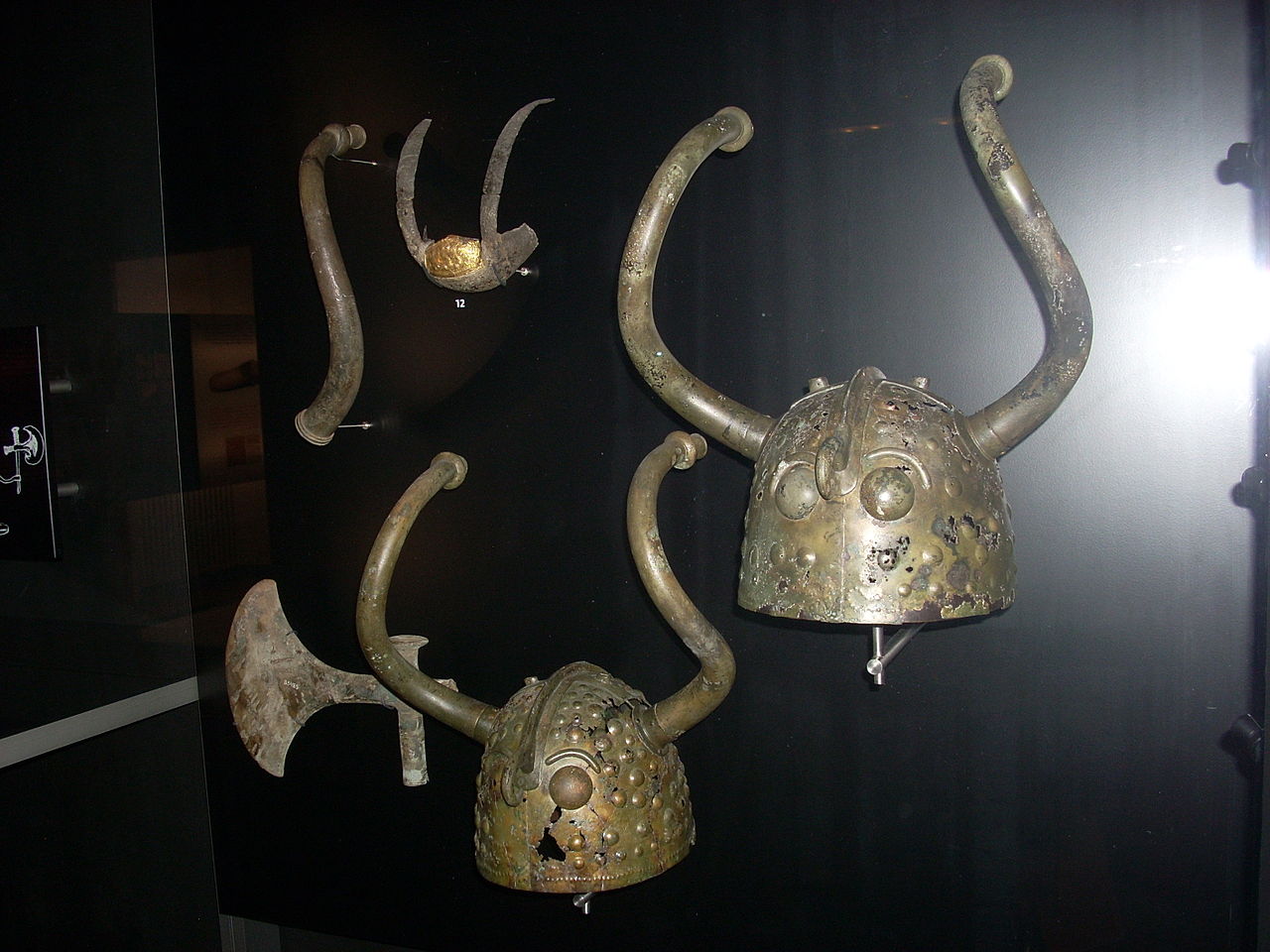
Ritualistic Bronze Helmets and Axe from Veksø, Denmark. We see here a culture that forming apart from its neighbors into some truly artistic and enigmatic directions. We can see a comparable with other parts of Europe in many artifacts but these are unique to the Nordic BA.

The Trundholm Sun Chariot Denmark. Wikipedia Open license to repost. Danish National Museum. The linkages to the later Norse mythology is visible in this spectacular artifact. Sunne or Sol carried across the sky on a chariot led by horses. The origin of this symbol is in contrast to native Scandinavians who venerated the boat but we see in the Bronze Age the chariot of the Indo-European Corded Ware people begin to be see on rock carvings and objects like this.
Axes, Solar or wheel symbols, Phalic fertility symbolism and Chariots…The Indo Europeans have arrived. The emphasis on Axes extends into cultures of Yamna origin such as the spectacular Hallstatt axes but no weapon is more widely depicted than the axe in Nordic glyphs. The stone age Axes of the “Battle Axe Culture” retained symbolic meaning well into the age of metallurgy. We see a similar tradition amongst Bell Beaker People who were buried with both copper and stone axes. the Beaker Folk are believed genetically to have risen from the “Single Grave Culture” in Denmark who were a subset of the CWC/Battle Axe Culture. Pics 1/2/3 Wikipedia Public Domain.


Stone Ships found on Gotland Island. (Wikipedia Public Domain)
Stone ship from Gotland Sweden. Another unique element of Nordic Bronze Age however the concept and use may date to the late Neolithic peoples. The tradition regardless persisted well through the Viking age in that boats were a noted tradition in Norse times either being burned or buried. These stone ships are found all over Scandinavia and Northern Germany. The tradition itself may predate Indo European migration and stem from the FunnelBeaker culture or older.
Photo credit Håkan Svensson. (Source Wikipedia). Gallery two (Wikipedia Public Domain) Germany, Sweden, Latvia. Some ships may date from the Iron Age but traditionally originated in Bronze Age or Earlier. *It is my speculation that these could be a late cultural remnant of the megalithic builders who entered and mingled with the Native Hunters in Scandinavia.



The mighty Axe. Symbol of power among more than just the Ancient Scandinavians. The axe was the default status weapon of the Northern Indo European peoples. Hallstatt and Scythians axes are among my favorite designs however the Nordic Axes are truly interesting due to the variety. (Top Picture is Public Domain) Pic 2/3 National Museum of Denmark.
Grooming:
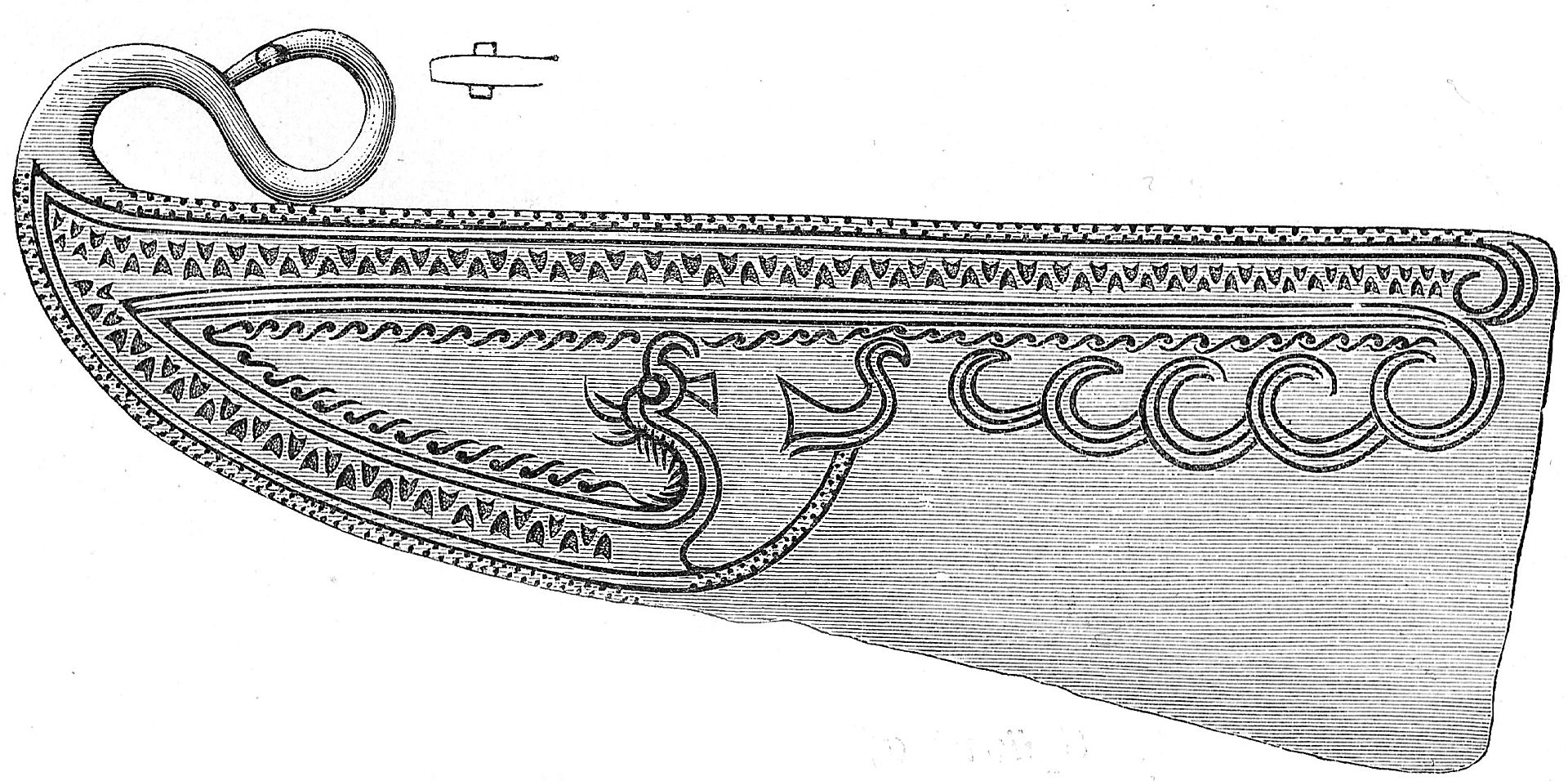

These unique bronze razors from Scandinavia give us a series of designs very distinct in Nordic art. These appear to share design elements with later Gotland picture stones. Do they also tell us of grooming habits?. Photos are of unknown origin. Credit to original artist.

Combs have traditionally been signs of status and good grooming. The Germanic people have produced beautifully detailed combs well through the Viking age. Comb is from Gotland Sweden. (Public Domain Wikipedia)
Farewell:
The Nordic Bronze age is marked by a change in burial practices. The Indo Europeans favored kurgans with rich grave offering. This tradition replaced preexisting burial practices in Scandinavia. A mound and oak coffin are customs of the Nordic Bronze Age but also across the whole of Indo European culture. The Bell Beaker culture brought the custom to Britain and Ireland.
An Oak coffin (Right) Danish National museum.
A Mound or Kurgan Dated to the Bronze Age in Sweden. Photo credit (Richard Johansson) or Kallerdis. (Source Wikipedia)
Burial practices differed in the NBA from the the earlier Neolithic tradition of tombs and communal burials. Grave offerings and elite single graves mark the period. This is to some extent consistent across Yamna dominated Europe.
Spirituality:
We can only compare and make educated guesses as to what the Nordic Bronze Age religion looked liked. We can obviously see a solar worship element. The Solar element can also be seen amongst Beaker folk and Central European cultures. But we are left to wonder what the Deities looked like. We do see figures in the stone carvings that could be Gods however we have no coherent view of what it all looked like. The Indo Europeans had a set mythology and we could postulate that these Gods were worshipped in Scandinavia likely with the Gods of the Native Scandinavians. The Sky Father, Thunder God and Mother Earth would be good guesses. Did the Axe Culture come from a lineage of worshiping an Axe/Hammer wielding God?. Did Nerðus begin her veneration amongst the Mesolithic Hunters who inherited an Earth Goddess from their Paleo European Ancestors? or was she an expression of an Indo European Earth Goddess. We have a statue from the NBA that shows two horned figures wielding axes though to represent sacred twins in Indo European mythology.

Also shown are other human figures from Bronze Mountings. Picture is from natmus.dk.
We see the themes of Indo Europeans culture fully take hold of all of Europe by the Bronze Age as well as the genetic lineage matching the CWC throughout Europe. Upon the arrival of the Bell Beaker People in Britain it is speculated that these people were responsible for the axe images carved into Stonehenge dated to the Copper/Bronze Age. It is roughly at this time we the greater split in IE groups into the culture and languages recognizable today. The Celts had long existed as the Nordic Bronze Age dawned as it was a later evolution than the rest of Europe due to the remote nature of Scandinavia. This is likely why native Hunter lineage also survived in a higher number (Haplogroup) than in other parts of Europe. It is the these unique features that make the Nordic Bronze highly fascinating.
Regions included in the greater Nordic Bronze Age horizons might include Scandinavia/Jutland, Northern Germany, Northern Poland and The Baltic States to some extent. This is not absolute however, as finds denoting NBA origin are found further afield than its traditional realm. The Haplogroups associated with the Late Neolithic and Nordic Bronze Age are I (Native European) and R1A/R1B (Indo European/Yamna).
Language:
The information I have read and looked over appears to point to this era as the origin of Proto Germanic splitting from PIE. We have no writing by Germanic people until they were regularly using the Elder Futhark to inscribe. We do not know the age of the Elder Futhark or its origin for certain though a plethora of opinions exist.
I hope you enjoyed this small glimpse into this era/speculated birth of Germanic Culture.
Interesting Links:
https://www.dandebat.dk/eng-dk-historie9.htm

Hroðbeorht-
Anglo-Saxon Word of þe dæg: Cunnende
Anglo-Saxon Word of þe dæg:
ᚪᚾᚷᛚᚩ ᛋᚪᛉᚩᚾ ᚹᚩᚱᛞ ᚩᚠ ᚦᛖ ᛞᚫᚷ᛫
Cunnende (present participle of Cunnan) ( cunning,clever,crafty,cute) from Proto Germanic “kunnana”. ᚳᚢᚾᚾᛖᚾᛞᚪ᛫
Compare:
West Germanic: *kunnan
Old English: cunnan
Middle English: cunnen, connen, can
Scots: can, cun, cunning
English: can, con, cun, could, cunning, canny
Old Frisian: kunna
North Frisian:
Föhr-Amrum: kön
Hallig: kune
Helgoland: kan
Mooring: koone
Sylt: ken
Saterland Frisian: konne
West Frisian: kinne
Old Saxon: kunnan
Middle Low German: künnen, kynnen, kunnen, konnen, können, kȫnen, konen
Low German: könen
Plautdietsch: kjanen
Old Dutch: cunnan
Middle Dutch: connen
Dutch: kunnen
Limburgish: kónne
West Flemish: keunn
Old High German: kunnan
Middle High German: kunnen, künnen
Alemannic German: chöne, chönne
Swabian: kenna
Sathmar Swabian: kenne
Central Franconian: kenne, könne, künne
East Central German:
Erzgebirgisch: kènn
Upper Saxon: gönn
German: können
Luxembourgish: kënnen
Rhine Franconian:
Pennsylvania German: kenne
Vilamovian: kenna
Old Norse: kunna
Icelandic: kunna
Faroese: kunna
Norwegian:
Norwegian Bokmål: kunne
Norwegian Nynorsk: kunne, kunna
Old Swedish: kunna
Swedish: kunna
Old Danish: kunnæ
Danish: kunne
Elfdalian: kunna
Gutnish: kunne
Gothic: 𐌺𐌿𐌽𐌽𐌰𐌽 (kunnan)
————————-
Bonus:
Prættig (pretty, cute, cunning) from Proto Germanic “Prattugaz”. ᛈᚱᚫᛏᚷ᛫
Compare:
Old English: prættiġ, prætiġ, pætiġ, petiġ
Middle English: prati, prety
Scots: pratty, ill-pretty, prety
English: pretty, pratty
Old Frisian: *pratig, *pretig
Saterland Frisian: prettig
Old Saxon: *prattig
Middle Low German: prattich
Low German: pratzig
Old Dutch: *prattig
Middle Dutch: *prattig, *prettig
Dutch: prettig
Old Norse: prettugr
Icelandic: prettugur
——————-
Anglo-Saxon Word of þe dæg: Mos-Meos
Anglo-Saxon Word of þe dæg:ᚪᚾᚷᛚᚩ ᛋᚪᛉᚩᚾ ᚹᚩᚱᛞ ᚩᚠ ᚦᛖ ᛞᚫᚷ᛫
Mos (moss,bog) from Proto Germanic “Musa”. ᛗᚩᛋ᛫
Also: Meos (moss)
Compare:
West Germanic: *mos
Old English: mos
Middle English: mos, mosse
Scots: mos
English: moss
Old Frisian: *mos
Saterland Frisian: Moas
West Frisian: moas
Old Saxon: mos
Middle Low German: mos
German Low German: Moss
Old Dutch: *mos
Middle Dutch: mos
Dutch: mos
Old French: mosse, mousseron
French: mousse, mousseron
English: mousse, mushroom
Old High German: mos
Middle High German: mos
German: Moos
Luxembourgish: Moos
Old Norse: mosi
Icelandic: mosi
Faroese: mosi
Danish: mose
Norwegian: mose
Old Swedish: mosi m, mosa (oblique cases); mos n
Swedish: mosse, mossa
Westrobothnian: môsa, mösa, måsa, mosa
————-
Bonus:
Swamm (mushroom, sponge) from Proto Germanic “swammaz”. ᛋᚹᚪᛗᛗ᛫ etymologically this is related to the word swamp.
Compare:
West Germanic: *swammOld English: swammMiddle
English: swam(Scots: swaam)(English: swamp)Old
Frisian: *swam, *swomSaterland Frisian: Swom, SwamWest
Frisian: swam
Old Saxon: swamm, swamMiddle Low German: swam
German Low German: Swamm
Old Dutch: *swammMiddle Dutch: swamme, swamDutch: zwam
Old High German: swamb, swam, swamp
Middle High German: swam, swamme, swamp
German: SchwammLuxembourgish: Schwamp
Old Norse: svǫppr, soppr, svampr
Icelandic: sveppur, svampur
Faroese: soppur, svøppur, svampur
Norwegian: svamp, sopp
Old Swedish: svamper, *sopperSwedish: svamp, sopp
Old Danish: swamp, *sop
Danish: svamp, svomp, sopWestrobothnian: sópp, sapp
Gothic: 𐍃𐍅𐌰𐌼𐌼𐍃 (swamms)
—————
Hroðberht-
Anglo Saxon word of þe dæg:Glēd
Anglo Saxon word of þe dæg:
ᚪᚾᚷᛣᚩ ᛋᚪᛉᚩᚾ ᚹᚩᚱᛞ ᚩᚠ ᚦᛖ ᛞᚫᚷ᛫
Glēd (ember,Fire, Live coal, Ash, spark, Flame) akin to shine, gleam, glow. From Proto Germanic “glōdiz”(glow/heat). ᚷᛚᛖᛞ᛫
Also: Fȳr (fire)
Example:
Iċ ēode þurh þæt fȳr and ne barn.
I walked through the fire and did not burn.
————
Þēah þe hit ċeald wǣre, ne ǣlde hē þæt fȳr.
Though it was cold, he didn’t light the fire.
—————
Þǣr þǣr smīec biþ, þǣr biþ fȳr.
Where there’s smoke, there’s fire.
——————
Compare:
West Germanic: *glōdi
Old English: glēd
Middle English: glede, gleede
Scots: gleed
English: gleed
Old Frisian: glōd, glēd
Saterland Frisian: Gloud
West Frisian: gloed
Old Saxon: glōd (in compounds: glōdpanna, glōdwelo, etc.)
Middle Low German: glōt
Low German: gloot
Plautdietsch: Gloot
Old Dutch: *gluod
Middle Dutch: gloet
Dutch: gloed
Limburgish: glood
Old High German: gluot
Middle High German: gluot
German: Glut
(Luxembourgish: Glous) (secondary influence)
Old Norse: glóð, *glœð
Icelandic: glóð
Faroese: glóð
Norwegian: glød
Old Swedish: glø̄þ
Swedish: glöd
Old Danish: glø̄th
Danish: glød
Scots: glude
—————-
Bonus:
īs (ice) from Proto Germanic “Isa”. ᛁᛋ᛫
īsiġ (Icey)
īsċeald (ice cold) 
Ic earmcearig iscealdne sæ winter wunade.
In winter I lived, wretched, on the ice-cold sea.
Compare:
West Germanic: *īs
Old English: īs
Middle English: is, ise, yes, yce, yys, ys, ijs, yse, ysz, hyse, hyys, ice, isse, ysse, yis
English: ice
Scots: ice
Old Frisian: īs
North Frisian: Iis, Is, is
Saterland Frisian: Ies
West Frisian: iis
Old Saxon: īs
Middle Low German: îs
German Low German: Ies
Plautdietsch: Iess
Old Dutch: *īs
Middle Dutch: ijs
Dutch: ijs
Limburgish: ies
Old High German: īs
Middle High German: īs
Alemannic German: Iis, Is, Isch
Alsatian: Iis; Eis (northern)
Italian Walser: isch, éisch
Bavarian: ais
Cimbrian: ais
Central Franconian: Eis, Ies
Luxembourgish: Äis
German: Eis
Frankfurt: [ais]
Pennsylvania German: Eis
Vilamovian: ajs
Old Norse: íss (< *īsaz)
Icelandic: ís
Faroese: ísur
Norwegian: is
Old Swedish: īs
Swedish: is
Danish: is
Elfdalian: ais
Gutnish: eis, h’eis
——————
Hroðberht-

